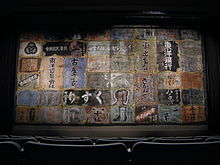- Front curtain
-
The front curtain, also known as the house curtain, act curtain, grand drape, main drape or main rag[1][2] is a stage curtain at the very front of a stage.
Typically, the front curtain is raised or opened at the beginning of a performance to reveal the stage set, and lowered during the intermission, as well as the end of a performance. The most common material for the front curtain to be made from is a heavy velour material, often with pleated fullness sewn into the fabric to create a more opulent appearance.
Contents
Curtain accents
 The stage curtain of Seattle's historic Nippon Kan Theatre, covered in painted ads.
The stage curtain of Seattle's historic Nippon Kan Theatre, covered in painted ads.
In some instances of both historical and modern theatres and opera houses, pictures or murals have been printed onto the front curtain, typically to accentuate or complement the architecture or stylistic theme of the theatre[3]. Graphics projected with gobos create a similar effect, or allow images relevant to the production to be seen. Stage lighting instruments may project coloured washes onto the front curtain. These washes help accentuate the front curtain, and the instruments which project the wash are known as "curtain warmers".
Types of curtains
The four most common types of house curtains are the french pleats (triple pleats), shirred, grommet and tab top.[2] The wipe style of front curtain is much less common, and typically seen only in smaller theatres.
Austrian
The Austrian curtain, much like the Venetian style curtain, has multiple vertical lines spread out across the length of the fabric. Unlike the Venetian, however, all these lines are linked together. When raised, this curtain creates a series of even swags along the bottom edge.
Traveller
The most common technique for opening a front curtain is a traveller. Traveller curtains remain at a fixed height and open and close horizontally, breaking in the middle. Flown curtains are typically a single large panel which travels vertically, being rigged by a fly system. Traveller style curtains can be rigged from a fly system as well, in which case they are referred to as bounce or guillotine curtains.[2]
Tableau
The Tableau, or Tab, curtain consists of two overlapping panels, with the lower onstage corners attached to lines. The curtain opens by pulling the fabric diagonally up and out, away from the center.
Venetian
The Venetian curtain, also known as the Profile or Contour curtain has multiple horizontal lines spread out across the length of the fabric. The curtain is opened by pulling on the various lines. Different shapes and heights of curtain opening can be created, since each line in the venetian curtain is independently operated. This type of curtain is also typically the most difficult type to operate because of the many lines.
Wipe
A wipe curtain, named after the film editing technique called a wipe, is rigged in a manner similar to a traveller, however, a wipe curtain opens from either the extreme left or right side of the proscenium opening and travels horizontally across the entire stage.
See also
- Fire curtain
- Theater drapes and stage curtains
References
- ^ Anderson, Robert (1980). Theatre Talk: An Illustrated Dictionary of Theatre Terms and Definitions. Pioneer Drama Service. p. 38.
- ^ a b c Friedman, Sally (1994). Backstage Handbook: an illustrated almanac of technical information. Broadway Press. ISBN 091174729X.
- ^ I. Weiss. "I. Weiss Portfolio, Balboa Theatre - San Diego". http://www.i-weiss.com/portfolio/details.src?ID=236.
Categories:
Wikimedia Foundation. 2010.

